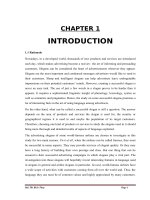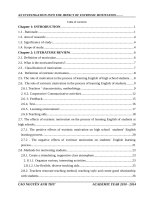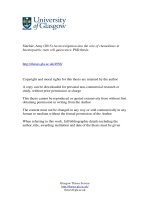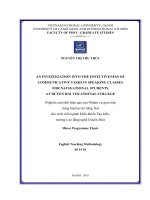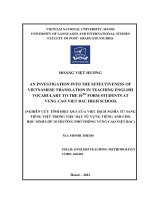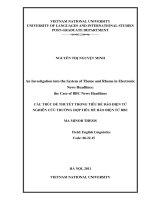An investigation into the language of appreciation in literature review of theses on language stu
Bạn đang xem bản rút gọn của tài liệu. Xem và tải ngay bản đầy đủ của tài liệu tại đây (2.14 MB, 94 trang )
THE UNIVERSITY OF DANANG
UNIVERSITY OF FOREIGN LANGUAGE STUDIES
LÊ THỊ HUYỀN KHANH
AN INVESTIGATION INTO THE LANGUAGE OF
APPRECIATION IN LITERATURE REVIEW OF
THESES ON LANGUAGE STUDIES IN ENGLISH
MASTER THESIS IN
LINGUISTICS AND CULTURAL STUDIES
OF FOREIGN COUNTRIES
Da Nang, 2020
THE UNIVERSITY OF DANANG
UNIVERSITY OF FOREIGN LANGUAGE STUDIES
LÊ THỊ HUYỀN KHANH
AN INVESTIGATION INTO THE LANGUAGE OF
APPRECIATION IN LITERATURE REVIEW OF
THESES ON LANGUAGE STUDIES IN ENGLISH
Major: ENGLISH LINGUISTICS
Code: 822.02.01
MASTER THESIS IN LINGUISTICS AND CULTURAL
STUDIES OF FOREIGN COUNTRIES
SUPERVISORS: HỒ SĨ THẮNG KIỆT, Ph.D
TRẦN HỮU PHÚC, Assoc. Prof. Dr.
Da Nang, 2020
ii
ABSTRACT
This thesis aims to explore the use of Appreciation through using linguistic
expressions to show the writers/ authors’ appreciative viewpoint in Literature review
of theses written in English in the light of Appraisal theory. The study focuses on
Appreciation, one of the three subsystems of Attitude within the Appraisal
framework. The descriptive quantitative and qualitative study was conducted based
on a descriptive framework of functional grammar and appraisal theory. The data
were extracted from literature review of master theses, written in English, in terms of
linguistics and English language on websites. 170 English samples showing the
authors/ writers’ viewpoint about prior studies such as noun phrases, verb phrases,
adjective phrases, clauses and sentences were collected from the literature review of
master theses. The sampling was done with random manner so that every sample has
the equal opportunity to occur in the data. The data were chosen, analyzed and
classified into two different categories in terms of syntactic and semantic features of
Appreciation in the review of literature. Syntactically, appreciation was examined in
view of clause as message and nominal groups in the light of functional grammar.
Semantically, appreciation was analyzed in terms of appraisal theory. Based on the
result of data analysis, some implications and suggestions comprehending and using
appreciation in showing writer’s appreciative viewpoint were given to Vietnamese
learners of English language and those who are interested in the Appraisal of
literature review in theses.
iii
TABLE OF CONTENTS
STATEMENT OF AUTHORSHIP ......................................................................... i
ABSTRACT .............................................................................................................. ii
TABLE OF CONTENTS ........................................................................................ iii
LIST OF ABBREVIATIONS................................................................................. vi
LIST OF TABLES ................................................................................................. vii
LIST OF FIGURES .............................................................................................. viii
CHAPTER 1. INTRODUCTION ............................................................................1
1.1. RATIONALE......................................................................................................1
1.2. AIM AND OBJECTIVES OF THE STUDY ...................................................2
1.2.1. Aim ..............................................................................................................2
1.2.2. Objectives ....................................................................................................2
1.3. RESEARCH QUESTIONS ...............................................................................3
1.4. SCOPE OF THE STUDY ..................................................................................3
1.5. SIGNIFICANCE OF THE STUDY..................................................................3
1.6. ORGANIZATION OF THE STUDY ...............................................................3
CHAPTER 2. LITERATURE REVIEW AND THEORETICAL BACKGROUND .5
2.1. PREVIOUS STUDIES .......................................................................................5
2.2. THEORETICAL BACKGROUND..................................................................7
2.2.1. Appraisal Theory.........................................................................................7
2.2.2. Appreciation ................................................................................................9
2.2.2.1. Definition of Appreciation ................................................................9
2.2.2.2. Types of Appreciation .......................................................................9
2.2.3. An overview of Syntax in Functional Grammar .......................................13
2.2.3.1. Clause as Message ..........................................................................14
2.2.3.2. Nominal group ................................................................................15
2.3. SUMMARY ......................................................................................................16
CHAPTER 3. RESEARCH METHODS ..............................................................17
iv
3.1. RESEARCH DESIGN .....................................................................................17
3.2. DATA COLLECTION ....................................................................................17
3.2.1. Sampling of the Study ...............................................................................17
3.2.2. Instruments of Data Collection .................................................................17
3.2.3. Procedures of Data Collection ..................................................................18
3.3. DATA ANALYSIS ...........................................................................................18
3.4. RELIABILITY AND VALIDITY ..................................................................18
3.5. SUMMARY ......................................................................................................19
CHAPTER 4. FINDINGS AND DISCUSSION ...................................................20
4.1. SYNTACTIC FEATURES OF LINGUISTIC EXPRESSIONS OF
APPRECIATION USED IN LITERATURE REVIEW OF THESES IN VIEW
OF FUNCTIONAL GRAMMAR ..........................................................................20
4.1.1. Appreciation in Literature reviews of linguistic master theses written in
English as Clause as Message ...................................................................................21
4.1.1.1. Appreciation in Simple sentences starting with ‘It’ ........................21
4.1.1.2. Appreciation in Simple Sentences ..................................................24
4.1.1.3. Appreciation in Complex Sentences ...............................................26
4.1.1.4. Appreciation in Compound Sentences ............................................29
4.1.1.5. Appreciation in Compound - Complex Sentences ..........................32
4.1.2. Appreciation in Literature reviews of linguistic master theses written in
English as Nominal Group ........................................................................................34
4.1.2.1. Appreciation in experiential structure of Nominal Group: Epithet,
Thing .........................................................................................................................34
4.1.2.2. Appreciation in experiential structure of Nominal Group: Deictic,
Epithet, Thing ............................................................................................................36
4.1.2.3. Appreciation in experiential structure of Nominal Group: Deictic,
Epithet, Classifier, and Thing....................................................................................38
4.1.3. Summary ...................................................................................................40
v
4.2. SEMANTIC FEATURES OF LINGUISTIC EXPRESSIONS OF
APPRECIATION USED IN LITERATURE REVIEW OF THESES IN VIEW
OF APPRAISAL THEORY ...................................................................................41
4.2.1. The reaction meaning of appreciation in Literature reviews of linguistic
master theses written in English ................................................................................41
4.2.1.1 Reaction: Impact ..............................................................................41
4.2.1.2 Reaction: Quality .............................................................................44
4.2.2. The composition meaning of appreciation in Literature reviews of linguistic
master theses written in English ................................................................................46
4.2.2.1 Composition: Balance ......................................................................46
4.2.2.2 Composition: Complexity ................................................................48
4.2.3. The valuation meaning of appreciation in Literature reviews of linguistic
master theses written in English ................................................................................51
4.3.
SUMMARY ...................................................................................................53
CHAPTER FIVE. CONCLUSION .......................................................................54
5.1. CONCLUSIONS ..............................................................................................54
5.2. IMPLICATIONS..............................................................................................55
5.2.1. To the Learners .........................................................................................55
5.2.2. To the Teachers .........................................................................................56
5.3. LIMITATIONS OF THE STUDY..................................................................56
5.4. SUGGESTION FOR FURTHER RESEARCH ............................................56
REFERENCES ........................................................................................................58
APPENDIX ..............................................................................................................63
vi
LIST OF ABBREVIATIONS
L1
First Language
L2
Second Language
SLSAS
Second Language Speaking Anxiety Scale
EFL
English as a Foreign Language
FLCAS
Foreign Language Classroom Anxiety Scale
UWL
University Word List
AWL
Academic Word List
IEP
Intensive English Program
R-I
Reaction-Impact
R-Q
Reaction-Quality
C-B
Composition-Balance
C-C
Composition-Complexity
vii
LIST OF TABLES
Number
Name of Tables
Page
Table 2.1
Sub-types of Appreciation (Martin & White, 2005, p.57)
11
Table 2.2
Types of Appreciation (Martin & White, 2005, p.56)
12
Table 2.3
Metafunctions and their reflexes in the grammar (Halliday,
2004,p61)
14
Table 4.1
Examples of Reaction-Impact Value of Appreciation
43
Table 4.2
Examples of Reaction-Quality Value of Appreciation
45
Table 4.3
Examples of Composition-Balance Value of Appreciation
47
Table 4.4
Examples of Composition-Complexity Value of Appreciation
50
Table 4.5
Examples of Valuation Value of Appreciation
52
viii
LIST OF FIGURES
Number
Name of Figures
Page
Figure 2.1.
An overview of appraisal resources (Martin & White,
8
2005, p.38)
Figure 2.2.
Types of Appreciation (Martin & White, 2005)
10
Figure 2.3
Structure of the Theme - Rheme (Halliday, 2004, p.66)
15
Figure 2.4
Experiential Structure of Part of a Nominal Group
16
(Halliday, 2004, p.312)
Figure 4.1
Appreciation in Simple sentences with ‘It’
23
Figure 4.2
Appreciation in Simple sentences with ‘It’
23
Figure 4.3
Appreciation in Simple sentence
24
Figure 4.4
Appreciation in Simple sentence
25
Figure 4.5
Appreciation in Simple sentence
25
Figure 4.6
Appreciation in Simple sentences
25
Figure 4.7
Appreciation in Simple sentences
25
Figure 4.8
Appreciation in Simple sentence
25
Figure 4.9
Appreciation in Complex sentence
27
Figure 4.10
Appreciation in Complex sentence
28
Figure 4.11
Appreciation in Complex sentence
28
Figure 4.12
Appreciation in Complex sentence
28
Figure 4.13
Appreciation in Compound sentence
29
Figure 4.14
Appreciation in Compound sentence
29
Figure 4.15
Appreciation in Compound sentence
Error!
Bookmark
not
defined.
Figure 4.16
Appreciation in Compound sentence
30
Figure 4.17
Appreciation in Compound sentence
30
ix
Figure 4.18
Appreciation in Compound-complex sentence
32
Figure 4.19
Appreciation in Compound-complex sentence
33
Figure 4.20
Appreciation in Compound-complex sentence
33
Figure 4.21
Appreciation in form of Nominal Group: Epithet,
35
Thing
Figure 4.22
Appreciation in experiential structure of Nominal
37
Group: Deictic, Epithet, Thing
Figure 4.23
Appreciation in experiential structure of Nominal
38
Group: Numerative, Epithet, Thing
Figure 4.24
Appreciation in experiential structure of Nominal
38
Group: Deictic, Epithet, Classifier, Thing
Figure 4.25
Appreciation in experiential structure of Nominal
39
Group: Deictic, Multi Epithet, Thing
Figure 4.26
Appreciation in experiential structure of Nominal
Group: Epithet as verb function
40
1
CHAPTER 1
INTRODUCTION
1.1. RATIONALE
It is generally agreed that language is an effective tool for human to transfer
and get information with a word, a very simple sentence or a complete, grammatical
form by different ways, written and spoken. Through different using purposes,
language is used as an instrument of thought or to conceptualize or represent the
experiential or real world to ourselves, including the inner world of our
consciousness.
The past decade has seen the evolution of a research paradigm of English
language study development. In addition, the quality and quantity of linguistic theses
have increased significantly. Especially, the importance of examining the
appreciation of authors in Literature Review through using the authors’ language
expressions is considered. They are sought in overview of other authors’ linguistic
researches.
While various studies have been previously conducted to study the aspects of
Appraisal theory, most are examined how to use the theory effectively. Besides, prior
studies are found in the linguistic features of appreciation function of language
towards subjects such as football commentaries, writings/ texts of learners of English,
political discourses. In other words, in this study, appreciation category is focused,
under the Appraisal theory, in terms of evaluating language in theses in English.
Specifically, the role of appreciation in using linguistic expressions to show the
author’s appreciative viewpoint in Literature review of theses is emphasized
obviously. Appreciation construes our evaluations of ‘things’. “Especially things we
make and performances we give, but also including natural phenomena – what such
things are worth (how we value them)” (Martin & White, 2005, p. 56).
Moreover, there are some gaps in previous studies which examined
appreciation attitude of the authors in literature review of theses. In fact, almost no
2
prior studies have mentioned the evaluative aspects of the language used by the
authors of theses. In fact, some language tools used for the literature review have been
mentioned, namely the reporting verbs. However, for example, in terms of English
language study, some authors analyze their modality-oriented researches, which only
examine the modal strength of reporting verbs, but little has dealt with indicating
evaluative category of the author’s language on the other authors’ work in the
Literature Review.
From these reasons stated above, I have decided to carry out the study entitled
“An Investigation into the Language of Appreciation in Literature Review of Theses
on Language Studies in English”. This is also the assignment needed to continue
clarifying gaps in literature. I attempt to analyze evaluative language of Appreciation.
Last but not least, it should be studied in extensive depth with the hope that the
investigation can make a significant contribution towards appreciation shown through
appreciation-functioned expressions in the view of Appraisal theory in theses in
English.
1.2. AIM AND OBJECTIVES OF THE STUDY
1.2.1. Aim
The study aims to examine the language of Appreciation through using
linguistic expressions in Literature Review of the English theses in the light of
Appraisal theory. It is expected to help language learners understand more clearly the
meaning and motivation for using linguistic expressions to express the author’s
appreciation in Literature Review.
1.2.2. Objectives
To achieve the aim of the study, the following objectives are intended:
1) To point out syntactic characteristics of linguistic expressions of
Appreciation used in Literature Review from English language master theses;
2) To find out semantic characteristics of linguistic expressions of
Appreciation used in Literature Review from English language master theses.
3
1.3. RESEARCH QUESTIONS
From the aims and objectives above, the study will be designed to answer these
following research questions:
1) What are the syntactic features that express appreciation in Literature
Review of English language master theses?
2) What are the semantic features of the appreciation in Literature Review of
of English language master theses?
1.4. SCOPE OF THE STUDY
The study primarily concentrates on the analysis of Appreciation in Literature
Review of theses on Language Studies written in English in terms of Appraisal theory
in its widest sense comprising features of syntax and semantics of the language
expressions of the authors. Appreciation – the language of evaluation, the last subcategory of Attitude in the Appraisal framework. Particularly, the syntactic
realization of appreciation was made in reference to the Functional Grammar
framework in terms of Clause as message. Semantically, appreciation is examined
with Appraisal framework such as, reaction-quality, valuation. Phonetic features of
speech acts like stress and intonation are put beyond the scope of this study.
1.5. SIGNIFICANCE OF THE STUDY
The findings of this investigation are expected to indicate the syntactic and
semantic features of appreciation in literature review of theses in terms of appraisal
theory. As a result, it can help learners understand more obviously the meanings and
goals for using linguistic expressions to express the author’s appreciation in
Literature Reviews in English. Hopefully, the study is used for learning, teaching and
researching English Language as far as Appreciation in academic works is concerned.
1.6. ORGANIZATION OF THE STUDY
This investigation includes five chapters as follows:
Chapter 1, Introduction, begins with the rationale for choosing the topic.
Next, aims and objectives of the research, research questions, the scope of the study,
4
the significance of the study and lastly the organization of the study are presented.
This chapter provides the framework of this study.
Chapter 2, Literature Review and Theoretical Background, deals with the
previous studies related to the research. Some concepts as well as a view of theoretical
background about appreciation are also considered.
Chapter 3 involving Research Methodology mentions research design,
research methodology, description of sample, data collection, instruments for
analysis, data analysis. It also consists of the reliability and validity of the thesis.
Chapter 4, Findings and Discussion, presents and discusses the findings of
this study. It concentrates on answering the research questions about the syntactic and
semantic features of appreciation in literature review on Language Studies written in
English. It presents the results and discusses the findings of the investigation.
Chapter 5, Conclusions and Implications, summarizes the main points of the
study as the conclusion. A statement of limitations and suggestions for further study
is also presented in this chapter.
5
CHAPTER 2
LITERATURE REVIEW AND THEORETICAL BACKGROUND
2.1. PREVIOUS STUDIES
Appreciation, a notion for explaining the way to express the attitude with
aesthetic principles, is a subcategory of Attitude drawn on Appraisal theory
framework proposed by Martin and his colleagues. According to Martin and White
(2005), the Appraisal framework was clearly stated in “The Language of Evaluation”
with the construction by texts of communities of shared feelings and values, and with
the linguistic mechanisms for the sharing of emotion, tests and normative assessment.
So far various studies on Appraisal theory regarding the use of evaluative
language have been carried out:
Whitelaw, Garag and Argamon (2005) stated in their research a new method for
sentiment classification based on extracting and analyzing appraisal groups. They
learned that use of features depended on appraisal group analysis can significantly
improve sentiment classification, despite the low coverage of our current appraisal
lexicon. Therefore, it is crucial to develop detailed and varied semantic tools to
support sentiment analysis.
Xinghua and Thompson (2009), drawn on the Appraisal theory (Martin &
White, 2005), report on a case study that investigated the use of evaluative language
between the high- and low- rated English argumentative essays by Chinese university
EFL students. The study found that the high-rated argumentative essay successfully
employed appraisal values to foreground authorial voice and position readers, thus
manipulating agreeability of utterances and building strong persuasion.
In addition, Neviarourskaya, Prendinger and Ishizuka (August, 2010) carried
out a research about Recognition of Affect, Judgement, and Appreciation in Text.
They classified the text using fine-grained attitude labels. They also introduced @AM
system, the only system allocating sentences using fine-grained attitude types and
dealing with the semantics of verbs in attitude analysis.
6
Moreover, Zhang (2015) compared the the appraisal resources of two sets of
disaster new reports over ten years from 1998 to 2008 collected from China Daily,
for examining whether there’s improvement in disaster reporting. This study shows
how to deal with Attitudes in the disaster news to embody human care to the victims
and yet keep the news reports objective.
Nguyễn Thị Thúy Loan (2015, Kalasin University, Thailand) and Issra
Pramoolsook (2015, Suranaree University of Technology, Thailand) conducted a
research how reporting verbs in Literature review chapters of TESOL Master’s theses
written by Vietnamese post graduates. The authors used Hyland’s (2002)
classification of reporting verbs in terms of their denotative and evaluative potentials.
This paper’s findings additionally reveal using reporting verbs randomly without
being aware of the rhetorical functions and some non-idiomatic expressions are also
identified.
Agata Križan (2016, University of Maribor Slovenia) explores the occurrence
and frequency of use of attitudinal judgement in British advertisement texts also in
the light of appraisal model (Martin & White, 2005). The research presents that
capability and propriety often participate in attitudinal double-coding due to the
brevity of advertising texts and the creativity of advertising language.
Besides, many Vietnamese linguistic researcher also have concerned the
evaluation of language, and they have thrown light on the Appraisal Theory. Nguyễn
Văn Khôi (2006) mentioned about Proclaim markers in English and Vietnamese
relied on a theoretical framework of Appraisal. The syntactic, semantic and pragmatic
features of proclaim markers are in epistemic modality, speech act, force dynamics,
politeness principles and dialogistic view were mentioned in his study.
What’s more, Trần Hữu Thuần (2014) carried out the investigation into the use
of Appreciation in football commentaries in English and Vietnamese in terms of
syntactic and semantic features based on Appraisa theory. His study also
concerntrated on finding out the similarities and differences of the appreciation in
football commentaries in both languages.
7
Trần Thị Ly (2015) investigated the category Attitude in English and
Vietnamese articles warning against childhood epidemics in view of Appraisal
framework. The study not only described the language use of all three Attitude’s sub
categories, including Affect, Judgement and Appreciation but also examined a wide
range of linguistic devices to mark the speakers or writers’s attitue with different
structures of verbs, adverbs, adjectives and nouns in the two languages.
Võ Nguyễn Thùy Trang (2016) searched and analyzed the languages of
Judgement and Appreciation in the category of Attitude in Nam Cao’s short stories
and the English translational equivalents based mainly on theories of Apprasial
framework. The study also considering the grammatical realization of Judgement and
Appreciation relied on Functional Grammar.
From the review of previous studies, it can be seen that the issues related to
Appraisal theory generally and Appreciation particularly have been carried out a lot
in both Vietnamese and English by not only Vietnamese authors but also foreign
authors. However, there has not been a study focusing on the linguistic features of
appreciation in Literature review in English language theses. Therefore, it is hoped
that this investigation will be a useful source for language learners of English to have
a better insight into the usage of appreciation in Literature review in English language
theses.
2.2. THEORETICAL BACKGROUND
2.2.1. Appraisal Theory
Appraisal Theory is a framework for analyzing the language of evaluation. It
has emerged from within Systemic Functional Linguistics (SFL) (Halliday &
Matthiessen, 2004) and was driven in its early days by work in the field of educational
linguistics and the development of Australia’s genre-based literacy programs
(Christine & Martin, 1997; Martin, 2000). It provides techniques for the systemic
analysis of evaluation and stance as they operate in whole texts in grouping s of texts.
Typically, Appraisal Theory was further developed by Martin and White. It is
“concerned with evaluation: the kinds of attitudes that are negotiated in a text, the
8
strength of the feelings involved and the ways in which values are sourced and readers
aligned.” (Martin & Rose, 2003, p.22). Appraisal theory is involved in the linguistic
resources for by which writers/ speakers come to express, negotiate and naturalize
particular inter-subjective and ultimately ideological positions (Martin and White,
2005). The resources of appraisal are used for negotiating our social relationship, by
telling our listeners/ readers how we feel about things and people (instead, what our
attitude are).
Appraisal theory has three domain sub-systems, namely Attitude, Engagement
and Graduation. Each of three sub-systems has certain sub-categories. Attitude is
concerned with our feelings, including emotional reactions, judgements of behavior
and evaluation of things. Engagement deals with sourcing attitudes and the play of
voices around opinions in discourse. Graduation attends to grading phenomena
whereby feelings are amplified and categories blurred (Martin &White, 2005, p.35).
Let us take a look at the figure below:
Monogloss
ENGAGEMENT
Heterogloss
AFFECT...
APPRAISAL
ATTITUDE
JUDGEMENT...
APPRECIATION...
Raise
FORCE
Low
GRADUATION
Sharpen
FOCUS
Soften
Figure 2.1. An overview of appraisal resources (Martin & White, 2005, p.38)
Attitude is a framework for three areas of personal feeling: emotion, ethics and
aesthetics. They refer to three semantic domains, namely Affect, Judgement and
9
Appreciation. Affect deals with feelings or emotional states and responses, such as
confident, frightened, etc. Judgement refers to the evaluation of human beings and/
or their behaviors, such as responsible, honest, etc. Appreciation considers the
evaluation of things, such as simple, important, etc.
2.2.2. Appreciation
2.2.2.1. Definition of Appreciation
Appreciation is recognized as the system by which various evaluations were
made of products, processes and entities are institutionalized. Appreciation refers to
how speakers evaluate a text or a process (Eggins & Slade, 1997, p.126). As can be
seen, appreciation customarily evaluates natural objects, created objects, texts as well
as more abstract constructs such as literature reviews, commentaries, etc. Moreover,
appreciation evaluates in different ways all things, including man-made objects,
events, things, appearance of human beings, languages.
Clearly, Appreciation mostly concerns with what is traditionally known as
aesthetic, for example: pretty, simple, attractive, etc. “Appreciation involves
evaluations of semiotic and natural phenomena, according to the ways in which they
are valued or not in a given field” (Martin & White, 2005, p.43).
For example: “Her impeccable recitation of the long poem is a thing of beauty.”
The appreciation value of “impeccable” in “impeccable recitation” shows a quality
attributed to “Her recitation of the long poem”.
Like both affect and judgement, values of appreciation have either positive or
negative assessments (e.g. positive: splendid, happy, etc.; negative: unhappy,
dangerous, etc.).
2.2.2.2. Types of Appreciation
Martin and White (2005, p.56) state that “Appreciations can be divided into our
‘reaction’ to things (do they catch our attention, do they please us?), their
‘composition’ (balance and complexity), their ‘value’ (how innovative, authentic,
timely, etc.)”.
10
For this explanation, Martin & White (2005) gave the illustrative realizations
for Appreciation divided into three types: reaction, composition and valuation.
They also stated that these sub-types are put in relation to mental processes, which
means how people look at things:
- reaction refers to affection in mental process category (emotive or desiderative).
- composition refers to perception in mental process category how order is viewed.
- valuation refers to cognition in mental process category, which means how
opinions are considered.
Types of Appreciation were illustrated and summarized in Figure 2.2.
impact
REACTION
reaction
-TYPE
arresting, captivating
Did it grab me?
quality
okay, fine, good
Did I like it?
balance
appreciation
APPRECIATION
composition
COMPOSITION
-TYPE
-TYPE
balanced, unified
Did it hang together?
complexity
simple, pure, elegant
Was it hard to follow?
valuation
penetrating, profound, innovative
Was it worthwhile?
Figure 2.2. Types of Appreciation (Martin & White, 2005)
Source:
11
As a result, it is found that three meta-functions are also clarified, linking to
three above sub-types within Appreciation framework respectively. Reaction is
interpersonal significance, composition is textual organization, and valuation is
ideational worth (Martin & White, 2005, p. 57) (as summarized in Table 2.1).
Table 2.1 Sub-types of Appreciation (Martin & White, 2005, p.57)
mental process type
metafunction
appreciation
reaction
affection
interpersonal
composition
perception
textual
valuation
cognitive
ideational
According to Rothery & Stenglin (in press) (For a review see Martin 1997: 2426), reaction is “interpersonally tuned. It describes the emotional impact of the work
on the reader/ listener/ viewer.” Hence, under reaction, the products/ processes are
evaluated in terms of the impact it makes or its quality. For example:
o Reaction-impact: positive - arresting, stunning, dramatic, etc.
o Reaction-impact: negative - dull, uninviting, monotonous, etc.
o Reaction-quality: positive - lovely, splendid, attractive, etc.
o Reaction-quality: negative - ugly, plain, etc.
Under composition, the product or process is evaluated according to its makeup,
according to whether it conforms to various conventions of formal organization.
According to Rothery & Stenglin (in press), ‘Composition is textually tuned. It
describes the texture of a work in terms of its complexity or detail.’ For example:
o Composition-balance: positive - unified, symmetrical, harmonious,
o Composition-balance: negative - unbalanced, incomplete, discordant,
o Composition-complexity: positive - simple, intricate, precise,
o Composition-complexity: negative - convoluted, simplistic.
Under valuation, the object, product or process is evaluated according to various
social conventions. This domain is very closely tied to field in that the social valuation
of one field will not be applicable or relevant in another. As a result, we would expect
that the set of social values which have currency in, for example, the visual arts, might
12
not have extensive application in the world of politics. In the context of the media
texts under which much of this theory was developed, the key values were those of
social significance or salience (whether the phenomenon was important, noteworthy,
significant, crucial, etc.) and of harm (whether the phenomenon was damaging,
dangerous, unhealthy, etc.), (For a review see Martin 1997: 24-26).
In short, according to Martin & White (2005), three sub-categories of
Appreciation were illustrated and listed together with words in both positive and
negative in Table 2.2 for reaction, composition, and valuation.
Table 2.2 Types of Appreciation (Martin & White, 2005, p.56)
Positive
Negative
Reaction
Impact
Reaction
– captivating, engaging …;
boring, tedious …;
exciting, moving …;
dry, uninviting …;
dramatic, intense …;
predictable, flat …;
remarkable, notable …
unremarkable, pedestrian ...
– Okay, fine, good …;
Yuk, bad, nasty …;
Lovely, splendid …;
Plain, ugly, grotesque ...;
Appealing, enchanting …
Repulsive, revolting …
Composition –
Balanced, harmonious …;
Unbalanced, discordant…;
Balance
Symmetrical, proportioned;
Uneven, flawed …;
Consistent, considered …;
Contradictory, disorganized;
Shapely, willowy …
Shapeless, distorted …
Composition –
Simple, pure, elegant …;
Ornate, extravagant …;
Complexity
Lucid, clear, precise …;
Arcane, unclear, woolly ...
Intricate, detailed …
Plain, simplistic …
Profound, deep …;
Shallow, reductive …;
Innovative, creative …’;
Derivative, conventional..;
Timely, landmark …;
everyday, common ..;
Authentic, real, genuine…
fake, bogus, glitzy …;
Appropriate, helpful …
ineffective, useless …
Quality
Valuation
13
2.2.3. An overview of Syntax in Functional Grammar
Halliday (2004, p.29) discussed that language construes human experience. It
names things, thus construing them into categories; and then, typically, goes further
and construes the categories into taxonomies, often using more names for doing so.
Similarly, language provides a theory of human experience, and certain of the
resources of the lexico-grammar of every language are dedicated to that function. He
also claimed that while construing, language is always also enacting: enacting our
personal and social relationships with the other people around us. Thus the clause of
the grammar is not only a figure, representing some process – some doing or
happening, saying or sensing, being or having – with its various participants and
circumstances; it is also a proposition, or a proposal, whereby we inform or question,
give an order or make an offer, and express our appraisal of an attitude towards
whoever we are addressing and what we are talking about.
As a result, Halliday (2004) developed the theory of the fundamental functions
of language, in which he analyzed lexico-grammar into three main metafunctions:
ideational, interpersonal and textual. Each of the three metafunctions is about a
different aspect of the world, and is concerned with a different mode of meaning of
clauses. He stated that whereas in the grammar of the clause each component
contributes a more or less complete structure, a clause is made up of three distinct
structures combined into one. He also split the component into two: experiential and
logical. Being about the natural world in the broadest sense, ideational metafunction
is involved with clause as representation. Focusing on the social world, especially
the relationship between speaker and hearer, interpersonal metafunction is related to
clause as exchange. Finally, reflecting the verbal world especially the flow of
information in a text, textual metafunction deals with clause as message. Table 2.3
shows a description the metafunctions, matches them up with three different
equivalent statuses in clause.
14
Table 2.3 Metafunctions and their reflexes in the grammar (Halliday, 2004,p61)
Metafunction
Definition
Corresponding
(kind of meaning)
status in clause
experiential
construing a model of experience Clause as representation
interpersonal
enacting social relationships
Clause as exchange
textual
creating relevance to context
Clause as message
logical
constructing logical relations
___
Each component defines complex units, and in some respects equivalent to a
word complex, a combination of words built up on the basis of a particular logical
relation. He called it is a group and he divided into three main classes of group:
nominal group, verbal group and adverbial group; along with a brief reference to
preposition and conjunction groups.
This thesis is concerned with the last metafunction: clause as message and the
logical component: nominal group. Appreciation in the thesis’s literature review is
seen as a message and nominal group.
2.2.3.1. Clause as Message
Clause as message is defined a clause which has meaning as a message, a
quantum of information by Halliday (2004, p.58). He also claims in all languages the
clause has the character of a message: it has some form of organization giving it the
status of a communicative event, but there are different ways in which this may be
achieved. In the clause as a message, there are theme and rheme.
a. Theme
Halliday (2004, p.64) explained that Theme is the element which serves as the
point of departure of the message; it is that which locates and orients the clause within
its context. Additionally, he stated that the theme is put first. Gerot and Wigneli
(1994), talking about theme, note that theme is what the clause is going to be about.
